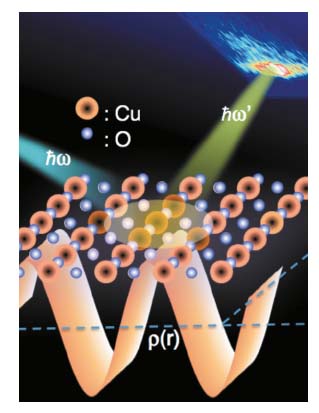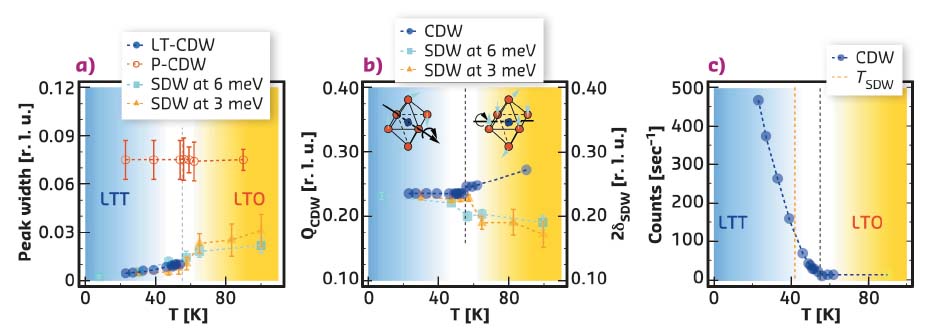- Home
- Users & Science
- Scientific Documentation
- ESRF Highlights
- ESRF Highlights 2017
- Electronic structure, magnetism and dynamics
- Precursor charge density waves in cuprates reveal spin-charge unlocked phase
Precursor charge density waves in cuprates reveal spin-charge unlocked phase
While charge density wave (CDW) correlations are ubiquitous to cuprates [1], their microscopic mechanism and relation with spin correlations remain enigmatic. X-ray experiments revealed high-temperature precursor CDW correlations that are decoupled from spin correlations. These observations help identify the universal properties of the state from which high-temperature superconductivity emerges.
Figure 107 shows the principle of resonant inelastic X-ray scattering (RIXS) measurements on cuprates. In the presence of charge density wave (CDW) correlations, the quasi-elastic RIXS intensity is peaked at a particular momentum transfer. By measuring the position and width of this peak the CDW wave vector and correlation length was extracted from the data. In this study, Cu L3 edge RIXS was used to achieve very high sensitivity to weak charge correlations.
 |
|
Fig. 107: Charge density waves ripple through a high-temperature superconductor. Resonant inelastic X-ray scattering experiments show that these excitations exist at temperatures above the CDW transition in the canonical stripe ordered cuprate La1.875Ba0.125CuO4. |
This works by choosing a photon energy that resonates with a Cu 2p → 3d core level transition in order to enhance scattering from valence electrons, while using the ID32 ERIXS spectrometer to reject the strong X-ray fluorescence that limits the sensitivity of traditional resonant soft X-ray scattering experiments. By carefully tracing the temperature dependence of the CDW peak, the CDW correlations were found to persist above the transition temperature with a correlation length that is more than ten times shorter than in the ordered phase. To distinguish between the low and high temperature CDW correlations, the CDW correlation above the phase transition are called precursor CDW correlations, as these are what order to form the low temperature phase.
In Figure 108, the temperature dependence of the CDW correlations is plotted. The correlation length of the precursor CDW of 13(2) Å is of a similar magnitude to several other cuprate systems such as Bi2Sr2-xLaxCuO6+δ (12 Å) [2], Bi1.5Pb0.5Sr1.54CaCu2O8+δ (< 24 Å) [3], La2-xSrxCuO4 (LSCO) (35 Å) [4] and HgBa2CuO4+δ (20 Å) [5], hinting that the high-temperature CDW properties may help reconcile the difference between different cuprates. Further clues are evident in the wave vector behaviour allowing the association of the high-temperature state observed here with the low-temperature behaviour of other compounds. As can be seen in Figure 108b, for temperatures below 55 K the incommensurability of the CDW and SDW appear to be locked by a factor of two, which is a well-known property of 214-type cuprates. Upon heating above 55 K, strong violation of this relation is seen: the CDW correlations evolve away from H ≈ 1/4 and away from twice the incommensurability of the spin density wave (SDW) (i.e. the CDW and SDW decouple).
 |
|
Fig. 108: Decoupling of the CDW and SDW in the high-temperature phase. a-c) The results of fitting the quasi-elastic intensity showing: a) the full width at half maximum, b) the incommensurability and c) the intensity at the peak. The black dashed line at 54 K corresponds to the low-temperature LTT-LTO structural phase transition, which is depicted in (b). Blue and yellow code temperatures below and above this threshold. The orange dashed line at 42 K in (c) represents the static SDW transition. The behaviour of the SDW, taken from inelastic neutron scattering results at 3 and 6 meV energy transfer are included on panels (a) and (b) [6]. |
These results establish shared properties between different cuprates and indicate that the wavevector of the CDW correlations may not reflect the formation mechanism of CDW, instead it is determined by a subtle balance of different competing interactions.
Principal publication and authors
High-temperature charge density wave correlations in La1.875Ba0.125CuO4 without spin-charge locking, H. Miao (a), J. Lorenzana (b), G. Seibold (c), Y. Y. Peng (d, e), A. Amorese (f), F. Yakhou-Harris (f), K. Kummer (f), N. B. Brookes (f), R. M. Konik (a), V. Thampy (a), G. D. Gu (a), G. Ghiringhelli (d, e), L. Braicovich (d, e) and M. P. M. Dean (a), PNAS 47, 12430-12435 (2017); doi: 10.1073/pnas.1708549114.
(a) Condensed Matter Physics and Materials Science Department, Brookhaven National Laboratory, Upton, New York, (USA)
(b) ISC-CNR, Dipartimento di Fisica, Università di Roma “La Sapienza” (Italy)
(c) Institut für Physik, BTU Cottbus, (Germany)
(d) Dipartimento di Fisica, Politecnico di Milano (Italy)
(e) CNR-SPIN, Politecnico di Milano (Italy)
(f) ESRF
References
[1] E. Fradkin et al., Rev. Mod. Phys. 87, 457 (2015).
[2] R. Comin et al., Science 343, 390 (2014).
[3] M. Hashimoto et al., Phys. Rev. B 89, 220511 (2014).
[4] V. Thampy et al., Phys. Rev. B 90, 100510 (2014).
[5] W. Tabis et al., Nat. Commun. 5:5875 (2014).
[6] M. Fujita, Phys. Rev. B 70 104517 (2004).



